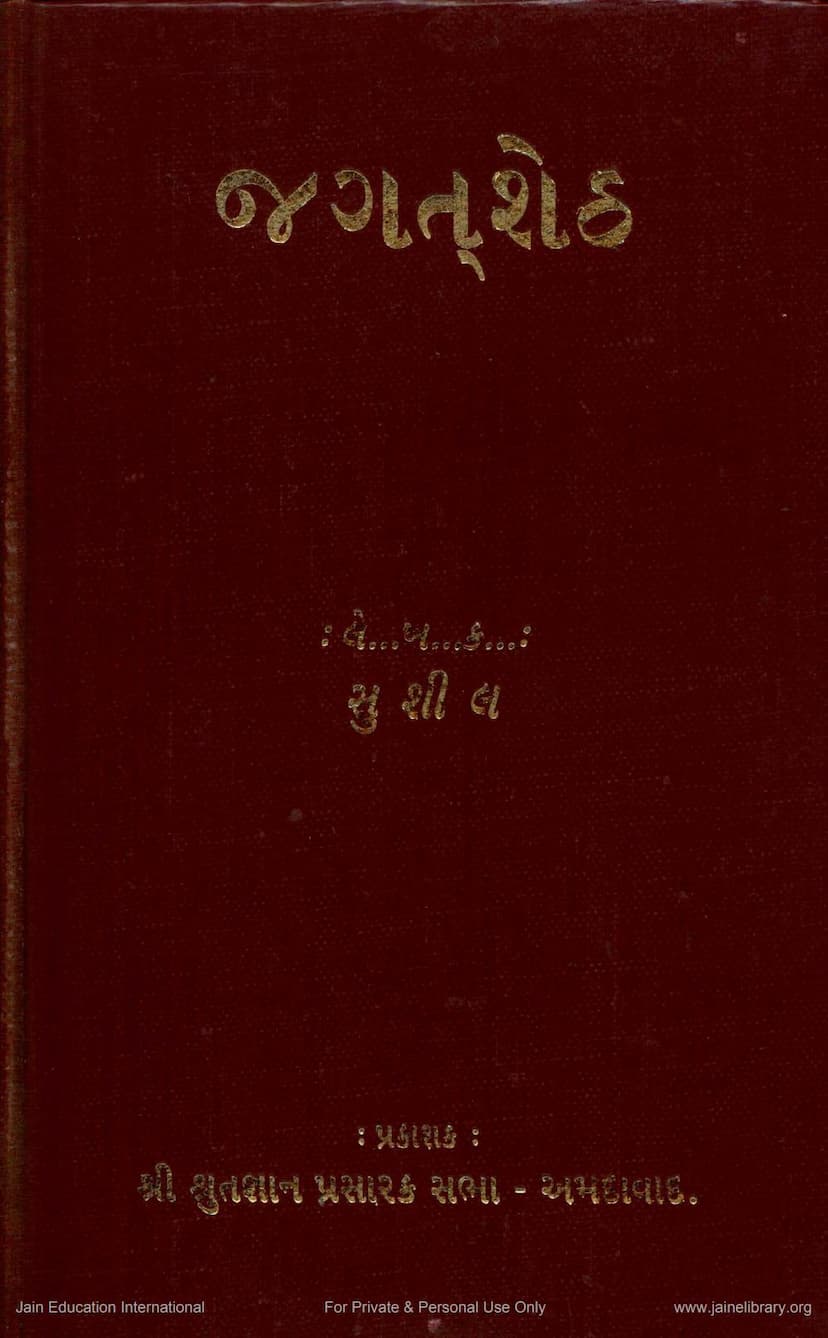Jagatsheth
Added to library: September 1, 2025

Summary
This document is a Gujarati book titled "Jagatsheth" by Sushil, published by Shrutgyan Prasarak Sabha, Ahmedabad. The catalog link provided leads to jainqq.org, which hosts digitized Jain texts.
Based on the provided pages, here's a comprehensive summary in English:
Book Title: Jagatsheth Author: Sushil Publisher: Shrutgyan Prasarak Sabha - Ahmedabad Publication Year: 2008 (Samvat 2064)
Overall Theme: The book "Jagatsheth" appears to be a historical narrative, likely a novel or biographical account, focusing on the influential Jain figure, Jagat Sheth, and his role in the history of Bengal, particularly during the tumultuous 18th century. The preface suggests that while Jain monks, scholars, and preachers are widely known, Jain figures in politics and administration are less recognized. The book aims to shed light on such historical figures, emphasizing Jagat Sheth's significant contributions and influence.
Key Themes and Content Highlights:
-
Historical Context: The preface places the narrative in the 18th century, describing it as a period of "terrible revolution" in Bengal's political landscape, marked by self-interest, greed, and conflict. Jagat Sheth is presented as a crucial figure who helped save Bengal during these challenging times.
-
Jagat Sheth's Role: The book aims to present a systematic history of Jagat Sheth, whose "skillfulness" and "public-mindedness" are evident in government and private documents, scattered correspondence, and charters. Lord Clive's words are quoted, describing him as an influential person who would offer sound advice for the country's safety and welfare.
-
Author's Intent: The author, Sushil, is credited with undertaking this work despite personal hardship (six months of jail and subsequent ill health). The intention is to bring to public attention the "bright national service" of the Jain community through Jagat Sheth's story.
-
Author's Preface (Page 6 onwards): Sushil's preface offers a meta-commentary on the nature of the work. He reflects on the title "an-avashyak" (unnecessary) and the irony of presenting something "unnecessary" when "necessary" things are overlooked. He describes his intention to write a historical novel, blending history with narrative. He acknowledges that the book might not be pure history or a pure story, and he hopes readers will appreciate the attempt to bring historical events to life with the inclusion of "ras" (flavor/interest).
-
Historical Figures and Events:
- Jagadushreshtha (Jagadushreshtha) and Ami Chand: The author clarifies that Jagat Sheth is not to be confused with others like Ami Chand and Maneck Chand, emphasizing the distinct lineage of the Jain Jagat Sheths.
- 18th Century Bengal: The text vividly portrays the political instability and corruption of 18th-century Bengal, with internal power struggles and the growing influence of European trading companies.
- Murshid Quli Khan and Maneck Chand: There are discussions involving Murshid Quli Khan, the Dewan of Bengal, and Maneck Chand, highlighting their strategic discussions about the political situation and the need for change in Dhaka.
- Farman and Titles: The book details the granting of titles like "Jagat Sheth" and the complexities of imperial decrees. It mentions the influence of the Mughal emperors and their changing fortunes.
- European Trading Companies: The role of English, French, and Dutch trading companies is discussed, noting their cunning policies and growing dominance. The book touches upon the impact of figures like Clive and Hastings.
- Slavery and Conquest: The narrative alludes to historical events like the impact of Nadir Shah's invasion and the Marathi incursions, and the eventual rise of British power.
- Mir Qasim and Mir Jafar: The book delves into the reigns and betrayals associated with Mir Qasim and Mir Jafar, and their interactions with Jagat Sheth.
- Siraj-ud-Daulah: The book portrays Siraj-ud-Daulah's character, his weaknesses, and the events leading up to his downfall, including the Battle of Plassey.
- Manik Devi: There is a significant section dedicated to Manik Devi, the mother of Jagat Sheth Fatehchand, highlighting her piety, charitable works, and spiritual devotion. Her life and ascetic practices are described in detail, including her influence on the family and her eventual spiritual liberation.
- The Jagat Sheth Dynasty: The book traces the lineage of the Jagat Sheths, starting from Shah Hirananand, and mentions various generations, their wealth, and their influence.
- The Jagat Sheth Family's Downfall: The later chapters discuss the decline of the Jagat Sheth family's fortunes due to internal disputes, financial mismanagement, and the growing power of the British East India Company. The loss of wealth and influence is depicted, culminating in the eventual erosion of their status.
- The "Jagat Seth" Title: The book clarifies that "Jagat Seth" was not just an individual's name but a royal title conferred upon generations of the family, signifying their supreme financial authority.
-
Literary Style: The preface suggests a blend of historical fact and narrative flair to engage the reader, aiming to present history in an "interesting" and "captivating" language. The author acknowledges potential historical liberties taken for the sake of narrative flow.
Overall Impression: "Jagatsheth" appears to be a well-researched and engaging historical account that aims to revive the memory of a significant Jain figure who played a pivotal role in the political and economic landscape of 18th-century Bengal. The book seems to highlight not only his financial acumen and political influence but also his religious devotion and philanthropic activities, particularly through the detailed portrayal of Manik Devi. The narrative likely offers a nuanced perspective on a complex historical period, emphasizing the contributions of individuals from the Jain community to broader Indian history.